By Elke Weesjes
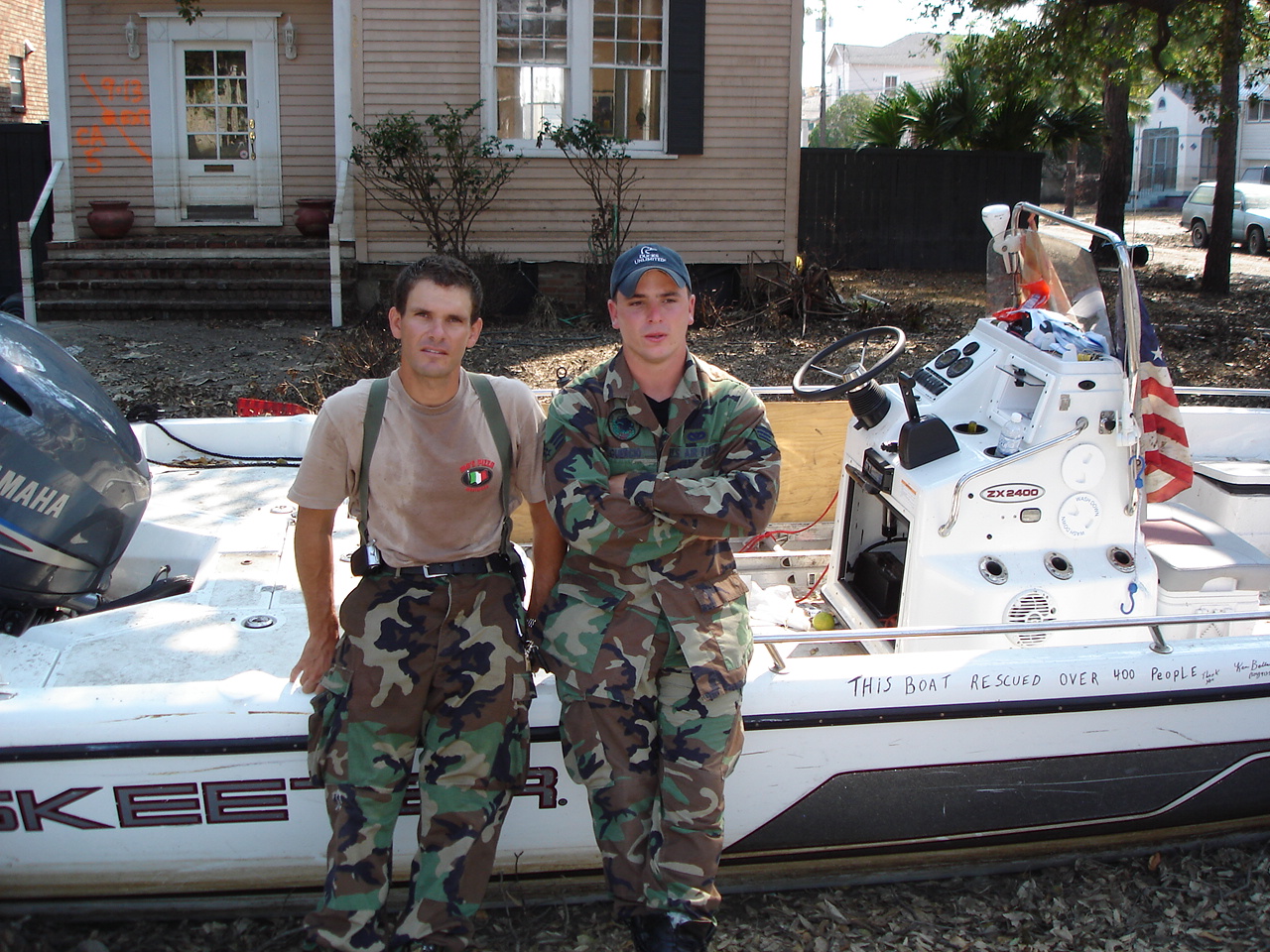
Kenny Bellau (left) in front of the boat he used to save hundreds of lives in the aftermath of Katrina © Kenny Bellau, 2005
WHEN BATON ROUGE and other areas of Louisiana flooded last summer, many of those active during Hurricane Katrina made their way to hard-hit Livingston Parish to offer help. Among them was Kenny Bellau, an eighth generation New Orleanian whose heroic efforts after Katrina helped save 400 lives. Curious about how the two efforts compared, I recently interviewed Bellau by phone. His accounts—some harrowing, some mundane—highlight the substantially different effects of flooding in urban and rural communities.
When Hurricane Katrina made landfall, Bellau, a semi-professional cyclist, was racing in French Guyana as a member of Herring Gas, a Louisiana-based cycling team. Worried about his cat and his family—especially his elderly mother—he hurried back to his beloved hometown. Bellau arrived two days after the levees broke and managed to talk his way into the closed-off city. He drove to his home, which was damaged but not flooded, and rescued his cat, Simon. His mother’s house, in a different part of town, was flooded and his elderly mother and brothers were nowhere to be found.
“I could not get in touch with either of my two brothers or my mom,” Bellau said. “They were smart enough to know that they should evacuate, but Katrina was the fifth time the city was asked to evacuate in the space of three or four years. And all those other times, the hurricanes took a left turn and we got nothing but a couple of bent trees in the city. People were exhausted. Every time my mom left, she was stuck in that crazy traffic and it would take countless hours to go a short distance. And then there were the stories of people breaking down while trying to leave, people getting robbed, and houses getting looted. As a result, many people in New Orleans decided to stay put. I wasn’t sure if anyone in my family was among them.”
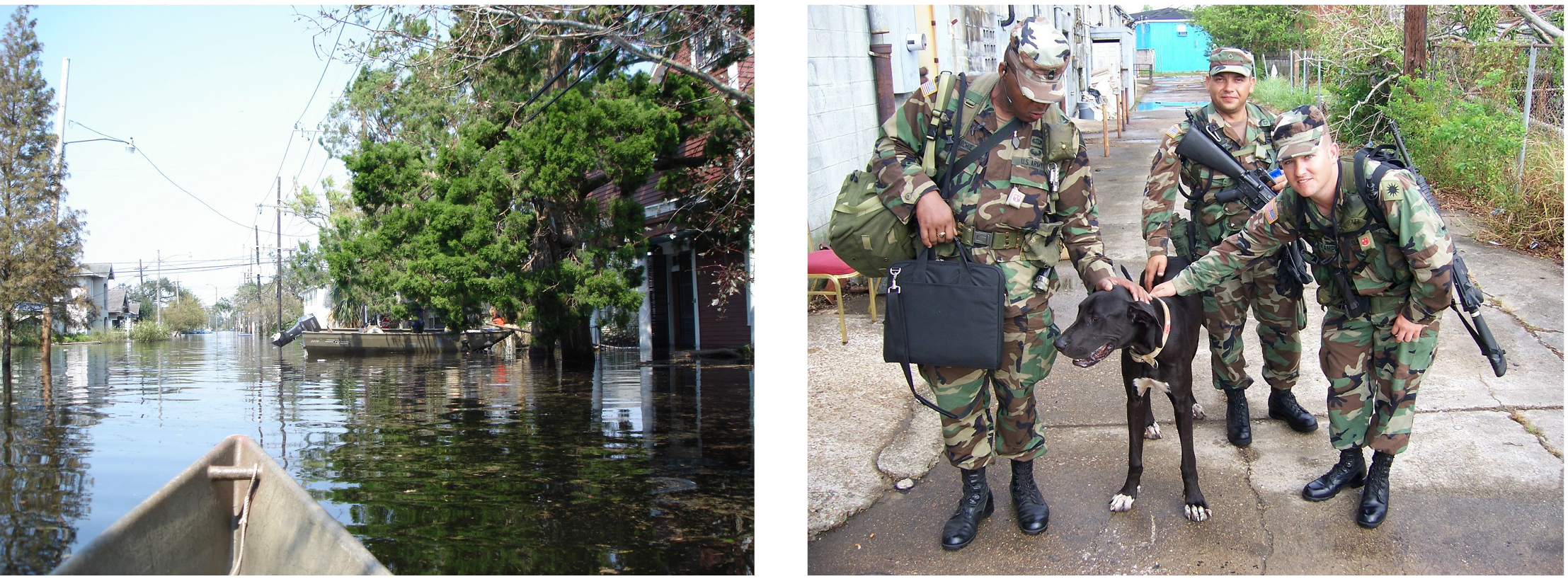
(l) “This is the bow of my pirogue. I took it from the facilities manager at Loyola University.” © Kenny Bellau, 2005. (r) Saving all lives © Kenny Bellau, 2005.
As it turned out, Bellau’s mother had evacuated a day before Katrina hit land. She had decided to go to a farm in Mississippi where she’d spent her childhood. The drive from New Orleans to the farm usually takes two hours, but on that day, it took 14 hours, Bellau said. Since his mother did not have a signal in the rural area she was staying and Bellau himself could only send text messages, it took some time before the two were able to connect.
While he was waiting to learn more, Bellau decided to look for other pets that were left behind by their owners. Swapping his car for a boat, Bellau roamed the flooded streets of New Orleans. He was assisted in his efforts by his now-wife Candy Johnson, who was living in Long Island, New York, at the time.
“Candy was looking on NOLA.com, on a blog where people were looking for their pets,” Bellau remembered. “She posted a message that explained that I was getting Simon and that I might be able to get other pets too. All the crazy cat people saw that message and contacted Candy, who in turn would send me text messages with their addresses. ‘Can you save my cat?’ quickly became ‘Can you save my dog?’ and by the time I got on a boat it became ‘Can you go and check on my grandmother?’ Once it [became requests to look for] people, it took me a little bit by surprise and I thought: I am here by myself; these people have no one else to turn to and they are not asking for their dog, they are asking for their family member.’ It still chokes me up a little when I think about it.”
At first Bellau used a pirogue, a Cajun canoe, to ferry people and animals to safety. After a few days, he spotted a group of police boats.
“I saw this flotilla of police boats and they were all from other states,” he said. “I repeatedly told the officers on the boats that I had this list of people who were stuck in their houses. They said, ‘Just give us the list and we’ll see if we can get to them.’ But they didn’t let me on their boats. They probably thought I was a crazy person, in fatigues and in a pirogue.”
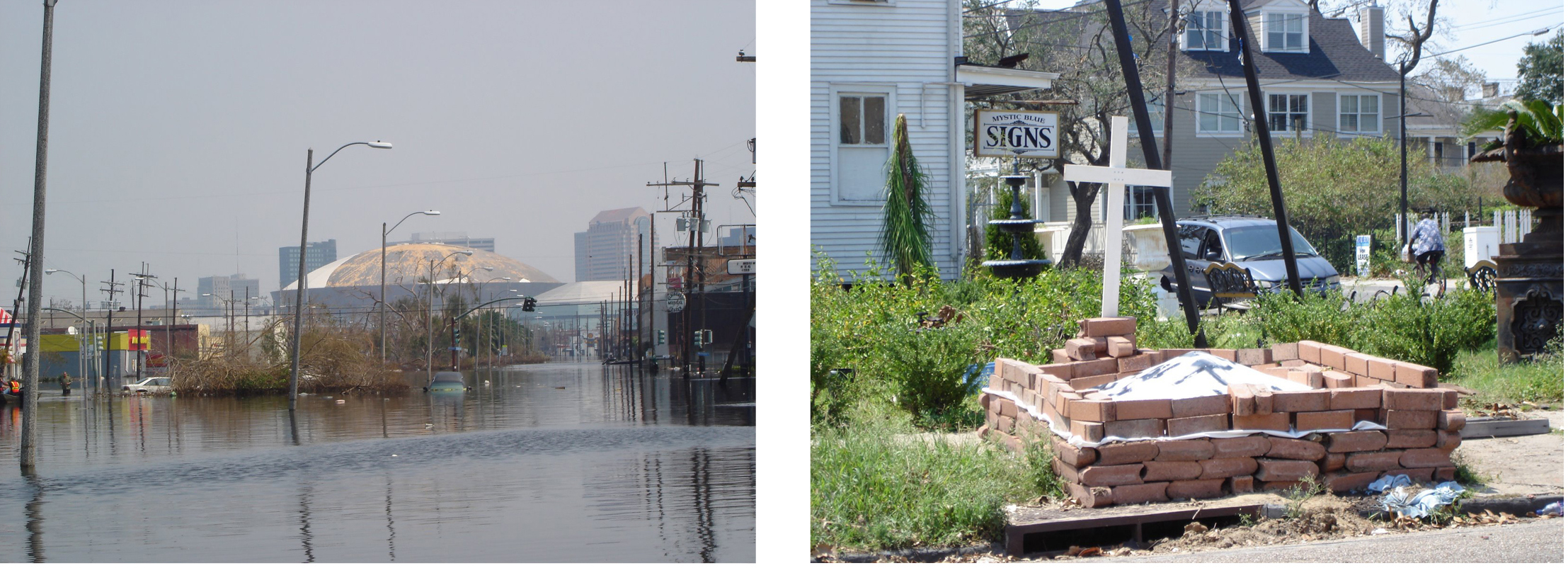
(l) Superdome New Orleans © Kenny Bellau, 2005. (r) "Here Lays Vera" © Kenny Bellau, 2005.
These officers were all from police forces outside of the city, explained Bellau. Once they got shot at by armed looters, they realized that they had no authority to do anything and were instructed by their superior to stand down.
“At that point, it was citizens vs. citizens. They could shoot back, but it wouldn’t be a police shootout with a looter,” said Bellau. “It would be a citizen from another state in a shootout with a looter. So their commanding officers told them to park their boats. I took one of these boats after they had left.”
One of the things that infuriated Bellau was the fact that other boat operators refused to rescue animals, which forced pet owners to choose between their personal safety and their pets. Bellau, however, made it his mission to save all lives, animals and humans. Fortunately, the military forces that arrived on the seventh day and teamed up with Bellau, shared his mission.
“The military put me in control over all the water rescues in uptown New Orleans,” said Bellau. “Every morning they gave me a platoon of soldiers and I told them every day that rule number one was that we’d take all living things. Dogs, cats, birds, they all came on the boat. The military guys loved that rule.”
The California National Guard turned to Bellau to lead rescue expeditions because he had already been so successful in rescuing people and animals. He also had a thorough knowledge of the city’s geography and the ability to understand the notoriously difficult local lingo.

(l) On the flooded streets of New Orleans © Kenny Bellau, 2005. (r) "Every day, we were swarmed by reporters. No one was doing rescue at this point but us. The NOPD had given up" © Kenny Bellau, 2005.
After 17 days, the water in New Orleans finally receded and the military ceased its search-and-rescue missions. Once the water had gone down, Bellau finally had a chance to inspect the damage on his mother’s house—the house he grew up in.
“My mom’s roof got destroyed so it got a lot of water in from the top and it flooded with five feet of water from the bottom. It was completely devastated,” Bellau said. “It was covered in mold and mud. At first glance, we thought that we would have to tear it down. But we didn’t tear it down, three years later, somebody bought it and renovated it.”
After Katrina, life returned to some kind of normalcy. Bellau, however, struggled much more with his experiences than he’d expected. He found it difficult to admit that he was suffering from Post Traumatic Stress Disorder.
“I am a person who is all about being an athlete and being part of a team,” he said. “And here I was after the storm. There was no team around me and I kind of isolated myself and didn’t seek out any help. One of my reasons for that was that I was on a boat with these soldiers who had lost friends in Afghanistan and Iraq. I didn’t want to feel sorry for myself for the things I saw during Katrina. It sounds silly but I didn’t feel worthy to even give myself the PTSD label. But eventually, I was talking to some of the army guys and they said, ‘you show all the signs, you have PTSD.’ But I never looked for professional help. I should have though. PTSD is a lonely and awful thing. I was angry at the world, I shut myself in, and stopped communicating with my friends and family.”
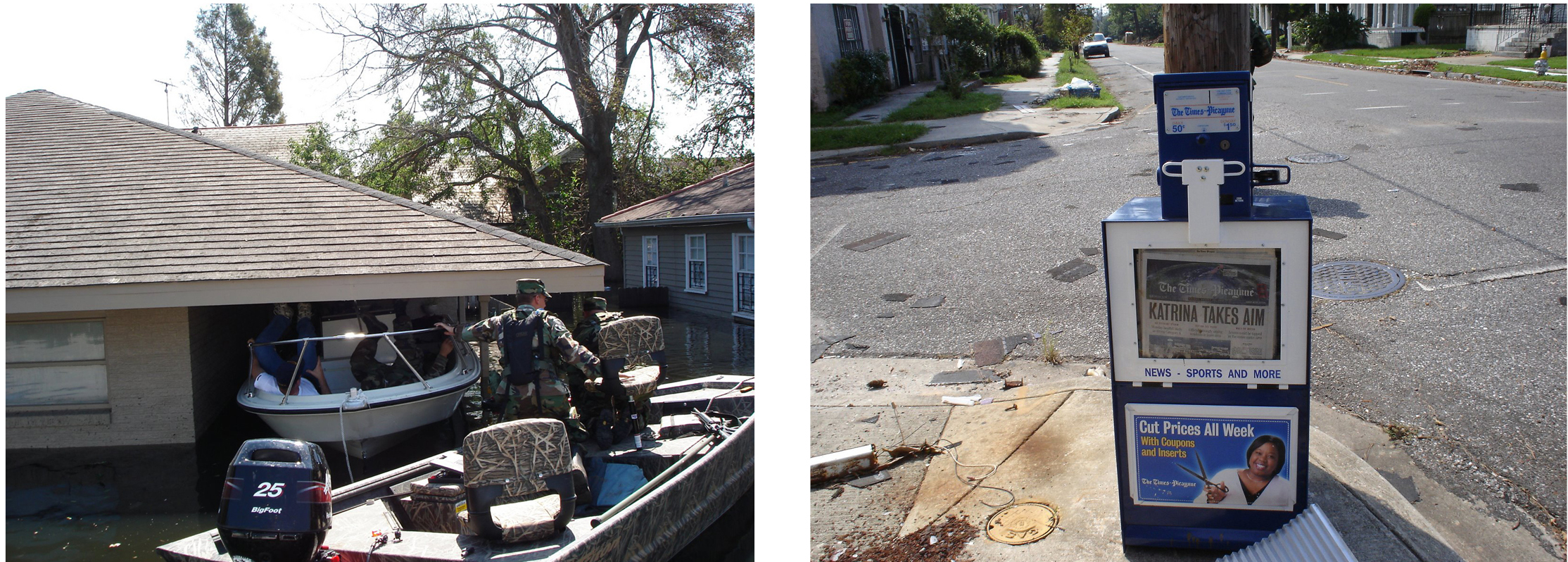
(l) "We took people's boats every day. We had no choice." © Kenny Bellau, 2005. (r) "Katrina Takes Aim" © Kenny Bellau, 2005.
After a long period of darkness and isolation, Bellau was able to turn things around. He got back on his bicycle and was able to process what had happened through physical activity.
“I started putting it out of my mind,” he said. “And then the five-year anniversary came around and that is when they took my boat and put it in a museum. I began to realize that I was lucky to have experienced Katrina. There were so many guys who wanted to help but they were stopped at the border of the city. People with boats tied up to their trucks, with goods, but the state police or the army turned them around. I was in the middle of it. And I kept on running into people who said ‘I wish I could have been there with you.’ I realized that I had seen something that not many others had seen. I also felt that I had a responsibility to tell the story.”
Bellau did indeed tell his story. He was featured in several national magazines and newspapers, including the Washington Post, Newsweek, and People magazine.
During the most recent flooding in 2016, Bellau wanted to use his unique experiences and expertise, so he jumped in his truck and drove to Baton Rouge. Considering the fact that he had struggled with PTSD for years this might come as a surprise, but, as Bellau explained, the responsibility he felt to help trumped everything. The situation in Baton Rouge, however, was very different, and in hindsight his help wasn’t as needed as it was back in 2005.
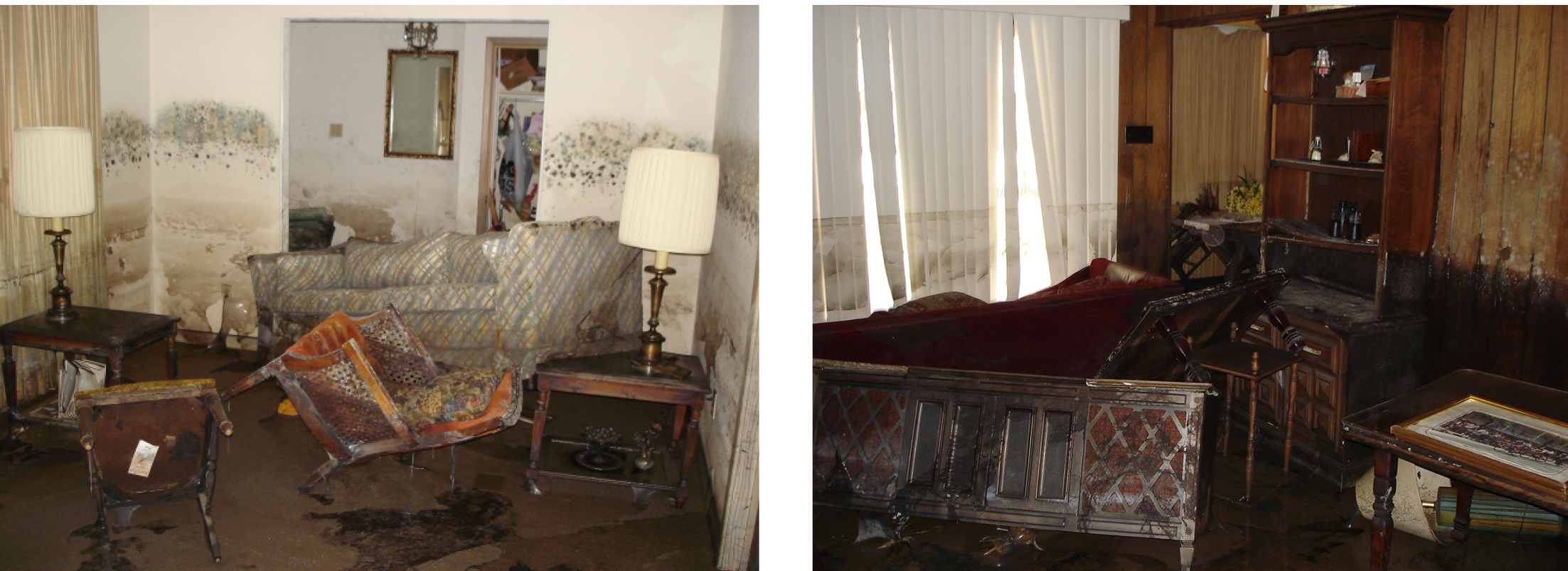
"My mother's house was completely devastated" © Kenny Bellau, 2005.
“Most of the land that was flooded around Baton Rouge was rural. There were only between 40,000 to 60,000 homes that were affected,” he said. “The damage to these houses was minor compared to the damage done by Katrina and the flooding that followed. The damage to the houses in Baton Rouge was the same or similar to Katrina, but without the wind damage. It was just a fraction of the number of houses in Katrina and there wasn’t the human suffering aspect. And the water was gone in a day or two, compared to 17 days after Katrina.”
You don’t have to rescue an Eskimo when it snows!
But the biggest difference, according to Bellau, was the level of resilience and resourcefulness in these rural areas.
“There were more people helping in Baton Rouge than people who needed help. I was at a loss for something to do. I was literally just in the way,” said Bellau. People in the city don’t really have the resources. They don’t have cars, boats, shotguns, and hip-waders; while the rest of Louisiana does. You don’t have to rescue an Eskimo when it snows!”
Still determined to do something, though, Bellau found a couple of local firemen who needed an extra pair of hands getting people out of their houses. He also ran into some women stranded in a car.
“Their car was stuck so I pulled them out with my truck,” he recalled. “They were trying to get to a relative of theirs. I used Google maps to find the address and dropped them off at their relative’s house, which was also kind of flooded but they felt they were good there. And that was about it. I kept on offering my help but the situation was under control. There were more boats leaving Baton Rouge than going in. In short, in Baton Rouge you had people with the resources who could help themselves. And there were a lot of people in surrounding areas who had learned their lessons from Katrina and were already prepared to go in.”
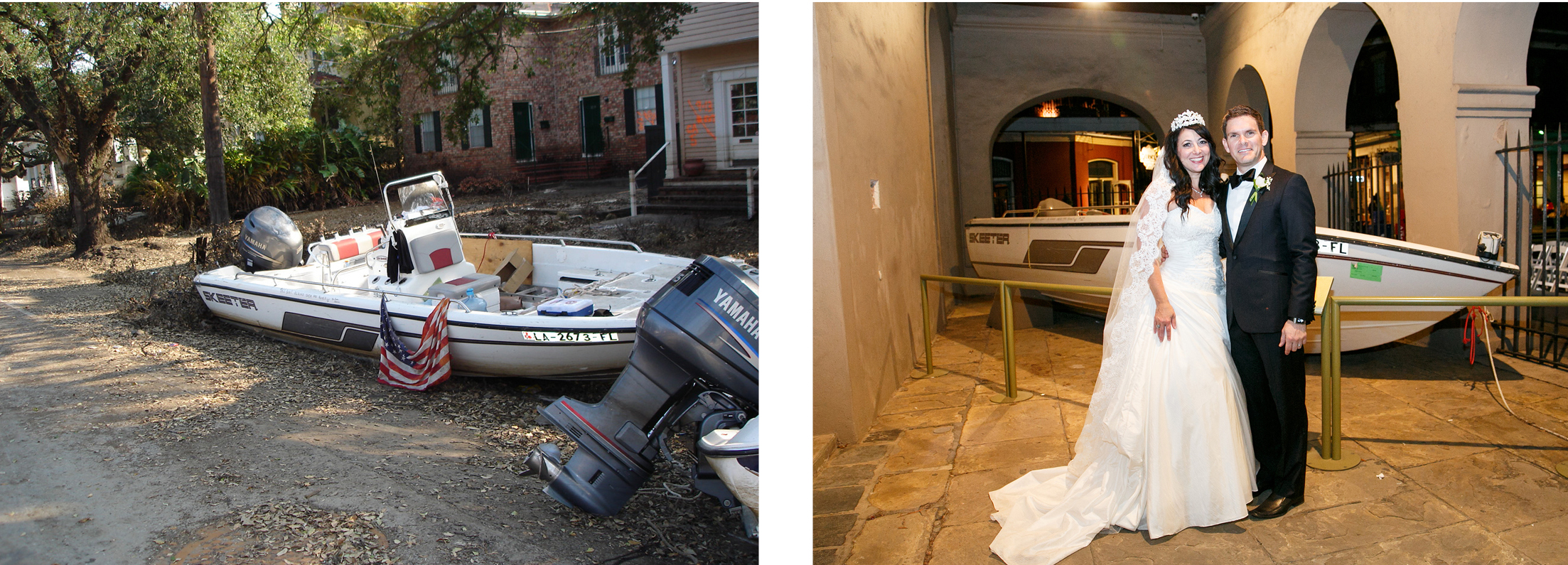
(l) The Boat © Kenny Bellau, 2005 (r) Candy Johnson and Kenny Bellau on their wedding day in front of the boat that is now part of an exhibit at New Orleans’ Presbytere museum © Kenny Bellau, 2012
Further reflecting on the disasters, Bellau noted that, compared to New Orleans, people in rural Louisiana didn’t like government intervention and had a do-it-yourself attitude. He also observed that while we often consider poor people and people of color as more vulnerable to disasters, this didn’t seem to be the case in those rural areas.
“I ran into a lot of black folk up there and they too had a boat, a gun, hip boots, and everything,” he said. “They didn’t need my help.”
This statement touches on what is perhaps the most important lesson we can learn from Bellau’s experiences and observations during these two disasters. Aside from populations, it is also vital that we identify locations (i.e. rural vs. urban communities) as vulnerable. It is clear that sometimes the assumptions we have about what people need and experience in a disaster are wrong—even (or especially) for someone with worst-case scenario experience.
Elke Weesjes Sabella is former editor of the Natural Hazards Observer. She joined the staff in December 2014 after a brief stint as a correspondent for a United Nations nonprofit. Under her leadership, the Observer was revamped to a more visual format and one that included national and international perspectives on threats facing the world. Weesjes was the editor of the peer-reviewed bimonthly publication United Academics Journal of Social Sciences from 2010 to 2013.
Weesjes Sabella also worked as a research associate for the Center for Disaster and Risk Analysis, formerly located at Colorado State University (although no longer active). In that role, she collected and analyzed data and translated research findings for a broader audience. She played a central role in finalizing the Disaster Preparedness among Childcare Providers in Colorado project, which examines all-hazards preparedness in daycares and in-home childcare across Colorado. She co-authored the report based on the first stage of the project, which was funded by Region VIII of the Federal Emergency Management Agency.
Weesjes Sabella specializes in cultural memory and neighborhood/community change in times of acute and chronic stress. She has published articles on the impact of drought on farming communities in Kansas, the effects of Superstorm Sandy in Far Rockaway, Queens, urban renewal in the Bedford-Stuyvesant neighborhood in Brooklyn, and health services for vulnerable populations in the South Bronx.
Weesjes Sabella received her PhD from the University of Sussex. Her dissertation, Children of the Red Flag: Growing up in a Communist Family During the Cold War (2012), as well as the majority of her publication record, share the common methodology of understanding culture and identity through oral history.